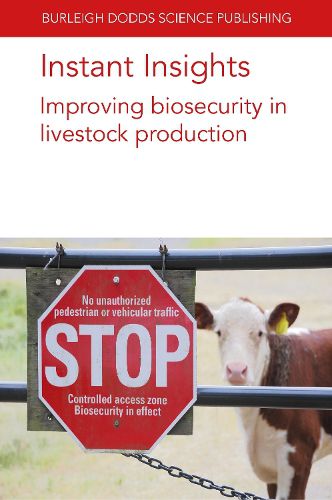Readings Newsletter
Become a Readings Member to make your shopping experience even easier.
Sign in or sign up for free!
You’re not far away from qualifying for FREE standard shipping within Australia
You’ve qualified for FREE standard shipping within Australia
The cart is loading…






This collection features five peer-reviewed reviews on improving biosecurity in livestock production.
The first chapter highlights the importance of implementing biosecurity measures along the pig production chain as a means of minimising disease introduction (external biosecurity) and spread (internal biosecurity) throughout the farm.
The second chapter reviews the diagnosis and monitoring of common pig diseases, as well as the control measures that can be implemented on the farm, focussing on the importance of establishing effective biosecurity measures.
The third chapter provides a brief overview of the emergence and re-emergence of several infectious pathogens of poultry. The chapter highlights the integral role of improving biosecurity in poultry flocks as a means of mitigating future disease risk, including proper cleaning and disinfection techniques.
The fourth chapter provides an overview of good farming practices for beef cattle farms, with particular discussion of biosecurity, animal welfare and the importance of clean cattle policies.
The final chapter summarises key issues of biosecurity which arise in organic animal farming and discusses their significance to human health. Two case studies are presented to demonstrate the successful implementation of biosecurity plans as a means of reducing disease risk.
$9.00 standard shipping within Australia
FREE standard shipping within Australia for orders over $100.00
Express & International shipping calculated at checkout
This collection features five peer-reviewed reviews on improving biosecurity in livestock production.
The first chapter highlights the importance of implementing biosecurity measures along the pig production chain as a means of minimising disease introduction (external biosecurity) and spread (internal biosecurity) throughout the farm.
The second chapter reviews the diagnosis and monitoring of common pig diseases, as well as the control measures that can be implemented on the farm, focussing on the importance of establishing effective biosecurity measures.
The third chapter provides a brief overview of the emergence and re-emergence of several infectious pathogens of poultry. The chapter highlights the integral role of improving biosecurity in poultry flocks as a means of mitigating future disease risk, including proper cleaning and disinfection techniques.
The fourth chapter provides an overview of good farming practices for beef cattle farms, with particular discussion of biosecurity, animal welfare and the importance of clean cattle policies.
The final chapter summarises key issues of biosecurity which arise in organic animal farming and discusses their significance to human health. Two case studies are presented to demonstrate the successful implementation of biosecurity plans as a means of reducing disease risk.